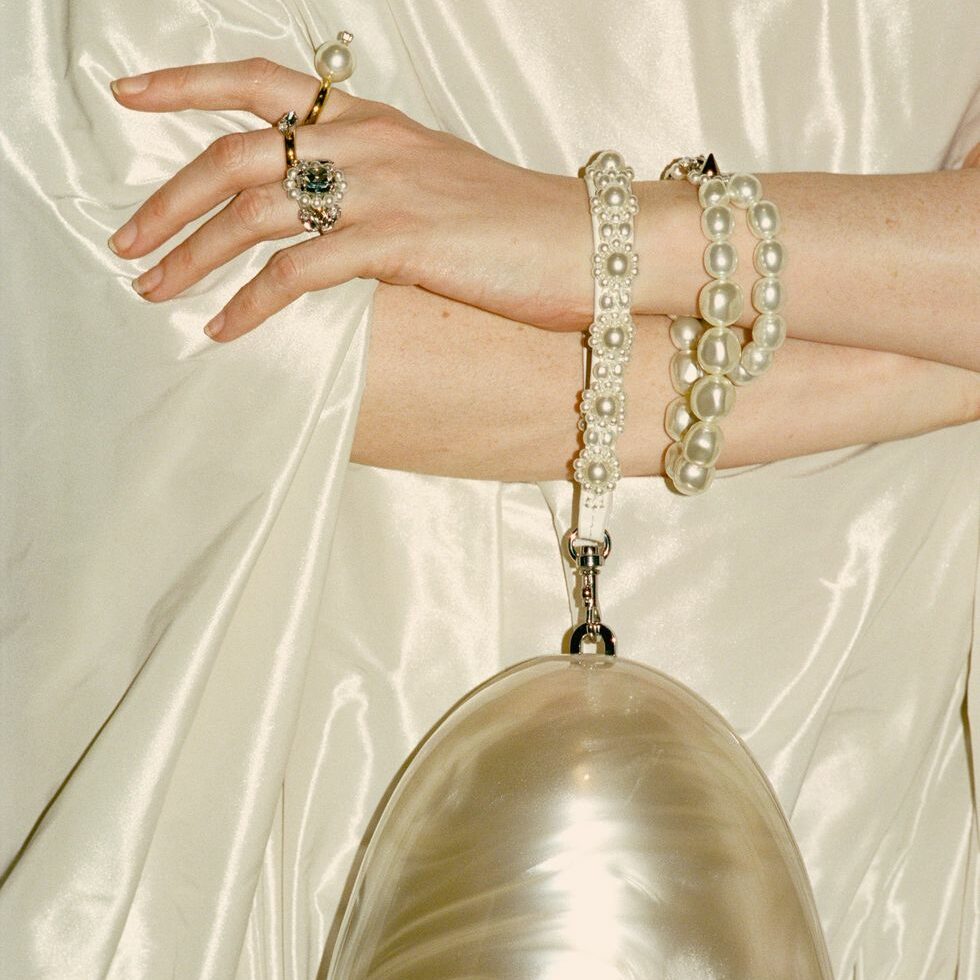Time to fetch your grandmother’s iconic pearl necklace from the cupboard and put it to the test.
Not so long ago many of us would’ve firmly stuck to the idea that pearls were ‘grandmother gems’. In their most classical form, they were used for those short necklaces we have all learned to identify with Audrey Hepburn or Jacqueline Kennedy, icons for our beloved grandmothers who might have owned something similar themselves. They have become heirloom staples, signs of prosperity and purity passed on from generation to generation.



In the past few years, however, re-interpretations of these iconic heirlooms have seeped into the high street in the form of chunkier gold chairs paired with imperfect pearl gems, or choker necklaces which have made appearances in some of the most iconic fashion runways. It isn’t solely fashion that has seen the revival of the pearl though: pearl-coated nails, homeware and purses are also at their prime. Although different, this fascination for the shiny and reflective can also be linked to the popularisation of metallic shades, especially in Gen-Z street style garments.
The Symbolisms
There is an ancient Persian myth that identifies pearls as the birth child of a rainbow and a storm, its imperfections blamed on the sheer power of thunder and lightning. It’s one of the many poetic myths and stories behind one of the most of classic gems, often present in family heirlooms, or even crushed and used for cosmetic purposes.
Real pearls come from mollusks, but unfortunately their formation is much less poetic than the myths lead us to believe. Pearls are the result of an irritant, such as a food particle, penetrating the mollusk and getting stuck inside. As a result, the mollusk coats the irritant with aragonite and conchiolin, the same two materials the animal uses to construct its protective shell. Contrastingly, faux pearls are made in a lab. There are several ways to go about it, with one of the most popular being made from plastic, coated glass or even mollusk shells.

But there is more beyond the duality of faux versus real pearls. The middle ground is what is known as cultured pearls, a process whereby molluscs intervene “by inserting a tissue graft from a donor mollusk, upon which a pearl sac forms, and the inner side precipitates calcium carbonate, in the form of nacre.” These make up the vast majority of the pearl market nowadays.
Whilst it may be virtually impossible to tell your cultured pearl from a naturally formed one, the veracity of the gems versus the man-made replicas can often be identified via a series of factors. You know the drill: scavenge that pearl necklace of yours from the wardrobe, and let’s figure out if those round things are the real deal.
Checking their Veracity
Analyse the Surface
One of the easiest ways to tell if a pearl is real or not is to check the surface. Real pearls have a unique texture that is often described as “gritty” or “sandy.” If you run your finger over the surface of a real pearl, you’ll feel small bumps and irregularities. Fake pearls, on the other hand, tend to be smooth and even in texture.
Look for Imperfections
Real pearls are produced naturally, which means that they often have imperfections. These imperfections can include small dents, bumps or irregularities on the surface of the pearl. If your pearls are perfectly smooth and flawless, there’s a good chance that they’re not real.
Examine the Colour
Real pearls come in a wide range of colors, including white, black, pink, and lavender. However, the color of a pearl can also give you a clue as to whether it’s real or fake. Real pearls tend to have a more subtle, natural-looking color, whereas fake pearls can look overly bright or artificially colored.
Check the Weight
Real pearls are heavier than fake pearls, so if your pearls feel unusually light, there’s a good chance that they’re not the real deal. Hold your pearls in your hand and compare their weight to that of a known real pearl. If they feel significantly lighter, they may be fake.
Try the Tooth Test
One of the oldest tricks in the book for identifying real pearls is the tooth test. Simply rub the pearl gently against your teeth. If it feels slightly rough or gritty, it’s likely that it’s real. If it feels smooth and slippery, it may be fake.
Where to Purchase Your Next Pearl Set
Wolf Circus Jewellery

This Vancouver-based jewellery line was founded in 2010, and features a wide range of delicate pearl pieces.
Having gone viral on Pinterest due to their unusual photography and unique marketing, their pieces are a hit amongst the fashion savvy looking to opt for something a tad more refined and elegant.
NST Studio

This Miami-based accessory line was founded by Natalia Solange Teran, and features handcrafted sea-inspired pieces. Through the use of shells and pearls in a myriad of shapes and sizes, their collections evoke contemporaneity and elegance like no other.
Missoma

With a particular focus on ethically sourced products, Missoma provides jewels for all kinds of wearers. Whether you’re on the hunt for something a bit more contemporary, or prefer opting for a more classical design, the Notting Hill brand has it all.


